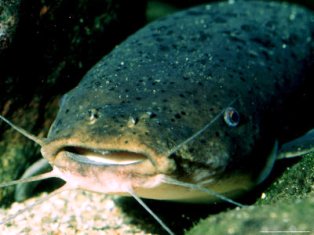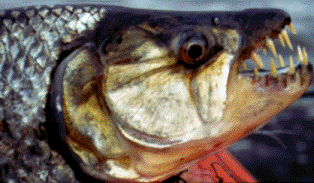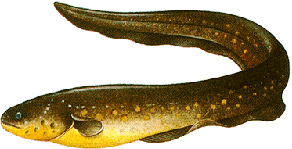Discover Florida Nature
It's time to explore the natural Florida


|
|
|
|
|
Prohibited species may be imported and possessed for research, following
approval of the research plan, including security measures to prevent
escape; and by public aquaria, zoological parks, or public exhibitors
with current accreditation by the American Zoo and Aquarium Association
or the American Association of Museums. Prohibited species may not be
kept as personal pets, with the exception of red-eared sliders that
were in possession prior to July 1, 2007. No exceptions are made for
piranha or pirambeba; these species are banned and may not be possessed
by anyone at anytime.  Electric
Catfish
(Malapterus electricus) Electric catfish are
relatively fat looking, and round in cross-section, like an over-stuffed
sausage. They have three pairs of barbels and dark vertical markings on
the caudal fin. They have no dorsal fins other than an adipose fin
located close to the tail, and are typically gray or brown in color.
Electric catfish are native to Africa, especially the Nile and Congo
river systems. Pairs breed in holes and crevices along the bank. A large
predator with a relatively unique feeding and defense mechanism,
electric catfish could potentially spawn in Florida and create both
ecological and potentially even human safety concerns. Their electric
organ is derived from pectoral muscle surrounding most of the body and
may discharge 300-400 volts. The entire family Malapteruridae is
prohibited in Florida. known to reach at least ten years of age, the
electric catfish may reach a length of four feet and weigh up to 45
pounds. Electric
Catfish
(Malapterus electricus) Electric catfish are
relatively fat looking, and round in cross-section, like an over-stuffed
sausage. They have three pairs of barbels and dark vertical markings on
the caudal fin. They have no dorsal fins other than an adipose fin
located close to the tail, and are typically gray or brown in color.
Electric catfish are native to Africa, especially the Nile and Congo
river systems. Pairs breed in holes and crevices along the bank. A large
predator with a relatively unique feeding and defense mechanism,
electric catfish could potentially spawn in Florida and create both
ecological and potentially even human safety concerns. Their electric
organ is derived from pectoral muscle surrounding most of the body and
may discharge 300-400 volts. The entire family Malapteruridae is
prohibited in Florida. known to reach at least ten years of age, the
electric catfish may reach a length of four feet and weigh up to 45
pounds. African
Tigerfish
(Hydrocynus) These fish are silvery in color, with dark
tiger-like stripes and a large mouth equipped with sharp conical canine
teeth. The African Tigerfish gets its name from the horizontal black
bands run along the entire body as much as from the fierce looking teeth
it possesses that show even when the mouth is shut. The pelvic fins are
arranged below the dorsal fin and the anal fin is far back below an
adipose fin. In most cases the caudal fin is deeply forked. African
tigerfish are native to Africa, including the Nile and Congo river
systems. The African Tigerfish is big, powerful, and well armed with big
evil looking teeth. These teeth have made the African Tigerfish one of
the most sought after exotic sportfish. These fish are relatives of the
Piranha but grow to be much larger than Piranhas. The giant tigerfish
can exceed 100 pounds and 4-feet in length. The African tigerfish is a
large predator that could potentially spawn in Florida and create
ecological problems. The entire subfamily Hydrocyninae is prohibited. African
Tigerfish
(Hydrocynus) These fish are silvery in color, with dark
tiger-like stripes and a large mouth equipped with sharp conical canine
teeth. The African Tigerfish gets its name from the horizontal black
bands run along the entire body as much as from the fierce looking teeth
it possesses that show even when the mouth is shut. The pelvic fins are
arranged below the dorsal fin and the anal fin is far back below an
adipose fin. In most cases the caudal fin is deeply forked. African
tigerfish are native to Africa, including the Nile and Congo river
systems. The African Tigerfish is big, powerful, and well armed with big
evil looking teeth. These teeth have made the African Tigerfish one of
the most sought after exotic sportfish. These fish are relatives of the
Piranha but grow to be much larger than Piranhas. The giant tigerfish
can exceed 100 pounds and 4-feet in length. The African tigerfish is a
large predator that could potentially spawn in Florida and create
ecological problems. The entire subfamily Hydrocyninae is prohibited. Airbreathing
Catfish (Clarias) These are elongated fishes with long
dorsal and anal fins and four pairs of barbels. An accessory organ (the
suprabranchial arborescent organ) associated with the gill cavity allows
the fish to "breathe" air. Typical species have stout pectoral spines
but lack a dorsal spine. Color is typically gray to brown, but albinos
are common in the aquarium industry. The entire family Clariidae is
prohibited in Florida, except the walking catfish which is already
established and hence is restricted. Initial concerns dealt with their
somewhat unique ability to move over moist ground between water bodies
and occupy a niche to which native species are not well adapted. They
are food fishes in their native range where their robust survival out of
water allows them to be kept fresh for the market. Typically found in
transient waters where other fishes do not thrive. the airbreathing
catfish native area is southeast Asia, including, Pakistan, eastern
India, Sri Lanka, Bangladesh, Myanmar, Thailand, Malaysia, Singapore,
Indonesia, and the Philippines. Airbreathing
Catfish (Clarias) These are elongated fishes with long
dorsal and anal fins and four pairs of barbels. An accessory organ (the
suprabranchial arborescent organ) associated with the gill cavity allows
the fish to "breathe" air. Typical species have stout pectoral spines
but lack a dorsal spine. Color is typically gray to brown, but albinos
are common in the aquarium industry. The entire family Clariidae is
prohibited in Florida, except the walking catfish which is already
established and hence is restricted. Initial concerns dealt with their
somewhat unique ability to move over moist ground between water bodies
and occupy a niche to which native species are not well adapted. They
are food fishes in their native range where their robust survival out of
water allows them to be kept fresh for the market. Typically found in
transient waters where other fishes do not thrive. the airbreathing
catfish native area is southeast Asia, including, Pakistan, eastern
India, Sri Lanka, Bangladesh, Myanmar, Thailand, Malaysia, Singapore,
Indonesia, and the Philippines.  Parasitic
Catfish (Pygidium itatiayae) Parasitic catfish, also
called the carnero or candiru fish, is a tiny parasitic catfish that
inhabits the waters of South America. They can reach lengths of 1-2.5
inches with a width of 1/4 inch. Their diminutive size and nearly
transparent body makes them very hard to locate. The parasitic catfish
has sharp bones with a series of spines located around the head used
while feeding. The candiru is found only in the Amazon and Oranoco
Rivers of South America. They do not like the sun and tend to bury
themselves in the mud and sand of the river bottom underneath logs and
rocks. To find a fish, the parasitic catfish first tastes the water,
trying to locate a water stream that is coming from the gills of a fish.
Once such a stream is detected, the candiru follows the stream to its
new host and inserts itself inside the gill flap. Spines around its head
then pierce the scales of the fish and draws blood while anchoring the
parasitic catfish in place. The candiru then feeds on the blood by using
its mouth as a slurping apparatus and while rasping the long teeth on
its top jaw. Parasitic
Catfish (Pygidium itatiayae) Parasitic catfish, also
called the carnero or candiru fish, is a tiny parasitic catfish that
inhabits the waters of South America. They can reach lengths of 1-2.5
inches with a width of 1/4 inch. Their diminutive size and nearly
transparent body makes them very hard to locate. The parasitic catfish
has sharp bones with a series of spines located around the head used
while feeding. The candiru is found only in the Amazon and Oranoco
Rivers of South America. They do not like the sun and tend to bury
themselves in the mud and sand of the river bottom underneath logs and
rocks. To find a fish, the parasitic catfish first tastes the water,
trying to locate a water stream that is coming from the gills of a fish.
Once such a stream is detected, the candiru follows the stream to its
new host and inserts itself inside the gill flap. Spines around its head
then pierce the scales of the fish and draws blood while anchoring the
parasitic catfish in place. The candiru then feeds on the blood by using
its mouth as a slurping apparatus and while rasping the long teeth on
its top jaw. Electric
Eel (Lepomis punctatus) Not a true eel, the electric
eel is a member of the family of naked knifefishes, that is nearly
scaleless, has no dorsal fin and a very long anal fin that is contiguous
with the caudal fin. The electric eel is brownish gray with an orange
patch under the chin. Pores used for electro-sensing prey are obvious
on the face. The electric eel uses the battery-like electric organs in
the posterior portion of the body to generate up to 600 volts. Although
a single fish is not normally lethal to an adult human, drowning can
result, and several eels may attack the same prey. Primarily nocturnal
they also use their electricity generating abilities to locate prey.
Growing to a length of eight feet or more the electric eel can weigh up
to 45 pounds. It's native range is in South America, where the electric
eel prefers slow moving water bodies Electric
Eel (Lepomis punctatus) Not a true eel, the electric
eel is a member of the family of naked knifefishes, that is nearly
scaleless, has no dorsal fin and a very long anal fin that is contiguous
with the caudal fin. The electric eel is brownish gray with an orange
patch under the chin. Pores used for electro-sensing prey are obvious
on the face. The electric eel uses the battery-like electric organs in
the posterior portion of the body to generate up to 600 volts. Although
a single fish is not normally lethal to an adult human, drowning can
result, and several eels may attack the same prey. Primarily nocturnal
they also use their electricity generating abilities to locate prey.
Growing to a length of eight feet or more the electric eel can weigh up
to 45 pounds. It's native range is in South America, where the electric
eel prefers slow moving water bodies
|
|
|
Advertise | Privacy Statement | Dog Encyclopedia | Video |Contact | Alaska Nature |
|